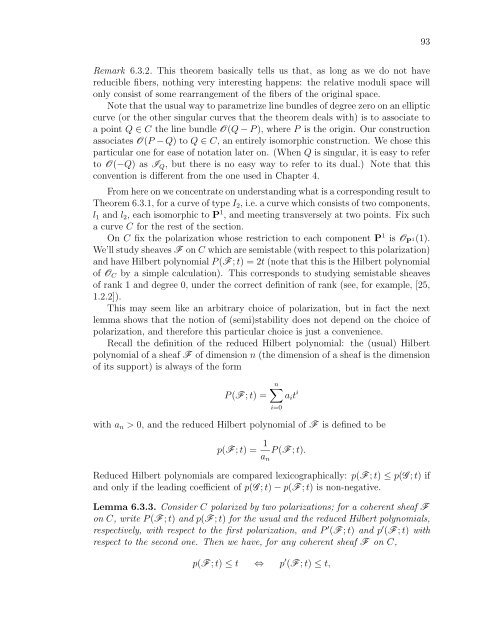derived categories of twisted sheaves on calabi-yau manifolds
derived categories of twisted sheaves on calabi-yau manifolds
derived categories of twisted sheaves on calabi-yau manifolds
You also want an ePaper? Increase the reach of your titles
YUMPU automatically turns print PDFs into web optimized ePapers that Google loves.
Remark 6.3.2. This theorem basically tells us that, as l<strong>on</strong>g as we do not have<br />
reducible fibers, nothing very interesting happens: the relative moduli space will<br />
<strong>on</strong>ly c<strong>on</strong>sist <str<strong>on</strong>g>of</str<strong>on</strong>g> some rearrangement <str<strong>on</strong>g>of</str<strong>on</strong>g> the fibers <str<strong>on</strong>g>of</str<strong>on</strong>g> the original space.<br />
Note that the usual way to parametrize line bundles <str<strong>on</strong>g>of</str<strong>on</strong>g> degree zero <strong>on</strong> an elliptic<br />
curve (or the other singular curves that the theorem deals with) is to associate to<br />
a point Q ∈ C the line bundle O(Q − P ), where P is the origin. Our c<strong>on</strong>structi<strong>on</strong><br />
associates O(P − Q) to Q ∈ C, an entirely isomorphic c<strong>on</strong>structi<strong>on</strong>. We chose this<br />
particular <strong>on</strong>e for ease <str<strong>on</strong>g>of</str<strong>on</strong>g> notati<strong>on</strong> later <strong>on</strong>. (When Q is singular, it is easy to refer<br />
to O(−Q) as IQ, but there is no easy way to refer to its dual.) Note that this<br />
c<strong>on</strong>venti<strong>on</strong> is different from the <strong>on</strong>e used in Chapter 4.<br />
From here <strong>on</strong> we c<strong>on</strong>centrate <strong>on</strong> understanding what is a corresp<strong>on</strong>ding result to<br />
Theorem 6.3.1, for a curve <str<strong>on</strong>g>of</str<strong>on</strong>g> type I2, i.e. a curve which c<strong>on</strong>sists <str<strong>on</strong>g>of</str<strong>on</strong>g> two comp<strong>on</strong>ents,<br />
l1 and l2, each isomorphic to P 1 , and meeting transversely at two points. Fix such<br />
a curve C for the rest <str<strong>on</strong>g>of</str<strong>on</strong>g> the secti<strong>on</strong>.<br />
On C fix the polarizati<strong>on</strong> whose restricti<strong>on</strong> to each comp<strong>on</strong>ent P 1 is O P 1(1).<br />
We’ll study <str<strong>on</strong>g>sheaves</str<strong>on</strong>g> F <strong>on</strong> C which are semistable (with respect to this polarizati<strong>on</strong>)<br />
and have Hilbert polynomial P (F ; t) = 2t (note that this is the Hilbert polynomial<br />
<str<strong>on</strong>g>of</str<strong>on</strong>g> OC by a simple calculati<strong>on</strong>). This corresp<strong>on</strong>ds to studying semistable <str<strong>on</strong>g>sheaves</str<strong>on</strong>g><br />
<str<strong>on</strong>g>of</str<strong>on</strong>g> rank 1 and degree 0, under the correct definiti<strong>on</strong> <str<strong>on</strong>g>of</str<strong>on</strong>g> rank (see, for example, [25,<br />
1.2.2]).<br />
This may seem like an arbitrary choice <str<strong>on</strong>g>of</str<strong>on</strong>g> polarizati<strong>on</strong>, but in fact the next<br />
lemma shows that the noti<strong>on</strong> <str<strong>on</strong>g>of</str<strong>on</strong>g> (semi)stability does not depend <strong>on</strong> the choice <str<strong>on</strong>g>of</str<strong>on</strong>g><br />
polarizati<strong>on</strong>, and therefore this particular choice is just a c<strong>on</strong>venience.<br />
Recall the definiti<strong>on</strong> <str<strong>on</strong>g>of</str<strong>on</strong>g> the reduced Hilbert polynomial: the (usual) Hilbert<br />
polynomial <str<strong>on</strong>g>of</str<strong>on</strong>g> a sheaf F <str<strong>on</strong>g>of</str<strong>on</strong>g> dimensi<strong>on</strong> n (the dimensi<strong>on</strong> <str<strong>on</strong>g>of</str<strong>on</strong>g> a sheaf is the dimensi<strong>on</strong><br />
<str<strong>on</strong>g>of</str<strong>on</strong>g> its support) is always <str<strong>on</strong>g>of</str<strong>on</strong>g> the form<br />
P (F ; t) =<br />
n<br />
ait i<br />
with an > 0, and the reduced Hilbert polynomial <str<strong>on</strong>g>of</str<strong>on</strong>g> F is defined to be<br />
i=0<br />
p(F ; t) = 1<br />
P (F ; t).<br />
an<br />
Reduced Hilbert polynomials are compared lexicographically: p(F ; t) ≤ p(G ; t) if<br />
and <strong>on</strong>ly if the leading coefficient <str<strong>on</strong>g>of</str<strong>on</strong>g> p(G ; t) − p(F ; t) is n<strong>on</strong>-negative.<br />
Lemma 6.3.3. C<strong>on</strong>sider C polarized by two polarizati<strong>on</strong>s; for a coherent sheaf F<br />
<strong>on</strong> C, write P (F ; t) and p(F ; t) for the usual and the reduced Hilbert polynomials,<br />
respectively, with respect to the first polarizati<strong>on</strong>, and P ′ (F ; t) and p ′ (F ; t) with<br />
respect to the sec<strong>on</strong>d <strong>on</strong>e. Then we have, for any coherent sheaf F <strong>on</strong> C,<br />
p(F ; t) ≤ t ⇔ p ′ (F ; t) ≤ t,<br />
93
















